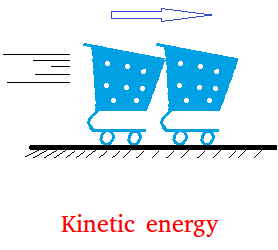What is kinetic energy?
When an object is in motion, it is capable of doing work. We say that the object has kinetic energy (KE) or energy of motion. Does it make
sense to you that the object is capable of doing work? Take a look at
the carts below.
The cart on the left is pushing the cart on the right and thus doing work on it or applying a force over a certain distance. The cart on the left has KE or energy of motion.

kinetic energy formula
Suppose an object has mass m and is moving with a speed v, we define kinetic energy (KE) as
The unit for the mass or m is kg, the unit for the speed or v is m/s, and the unit for the kinetic energy or KE is joules.
Derivation of kinetic energy formula
To derive the formula, we will need a few concepts.
- We will need Newton's second law of motion.
- We will need one of the constant acceleration equations
- We will need the work formula.
F = ma equation 1
v2 = v02 + 2ad equation 2
W = Fd equation 3
We will combine these 3 equations, do some math, and finally arrive at the formula for kinetic energy.
We will start with W = Fd since what we are looking is the work a moving object can do.
W = F × d
Using equation 3, substitute ma for F
W = ma × d equation 4
Now, use equation 2 to solve for a
v2 = v02 + 2ad
v02 + 2ad = v2
Let v0 = 0. Why? Since the object is usually at rest before starting moving, the initial speed will be zero then.
02 + 2ad = v2
0 + 2ad = v2
2ad = v2
Divide both sides by 2d
Replace the value of a in equation 4
Substitute KE for W since the work done by a moving object is called KE or kinetic energy.
An important observation about the kinetic energy
Notice that the speed is squared. What happens if we double the speed?
Let v be the speed of a moving object. Let speed = 2v after the speed is doubled.
The 4 that you see means that the kinetic energy is quadrupled.
Whenever the speed is doubled, the kinetic energy is quadrupled.